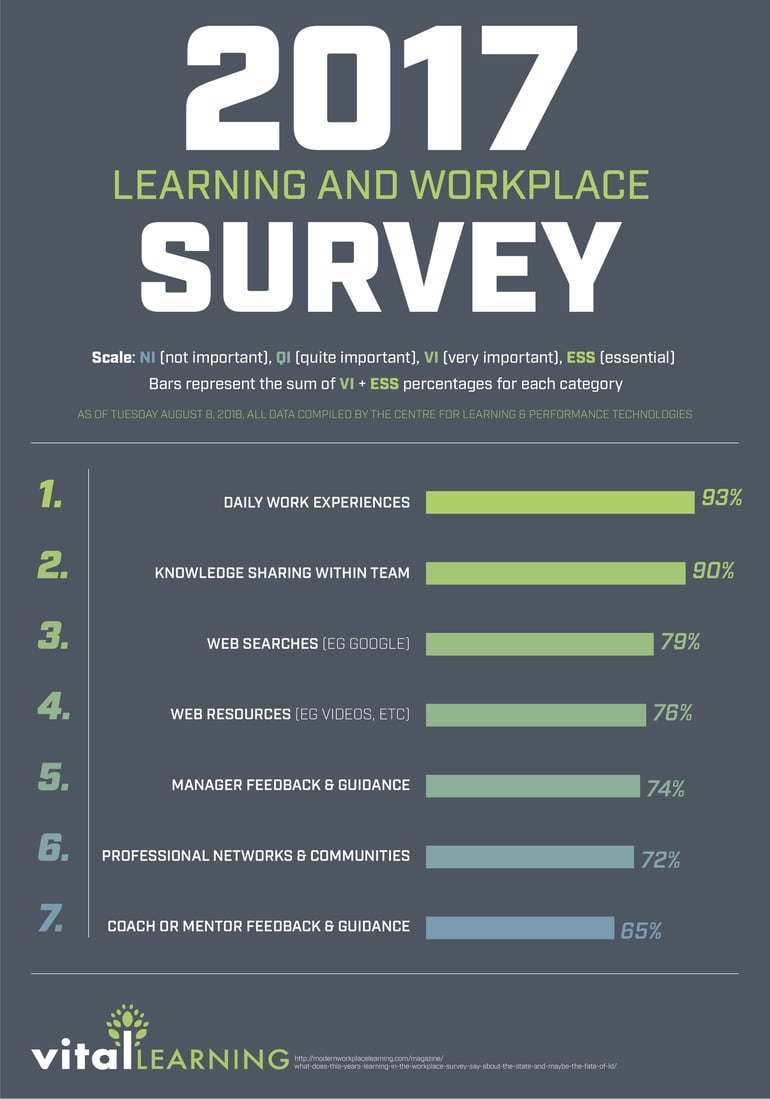Learning and Development is a rapidly changing industry...
The L&D industry has evolved a great deal in the last few years. Workplace training has become less project based, and more integrated into workers’ day-to-day. As a result of this higher demand for workplace training comes a higher saturation of content, making those who can select and implement the best programs essential to their organization. How we define ‘quality’ training in the learning and development industry will be top of mind in 2018, and sifting through the noise will be increasingly important. Understanding the future of L&D, knowing what to do about changing tides, and implementing change accordingly are all things that can be done with ease, as long as the right steps are taken.
1: Checking boxes won't suffice anymore...
2017’s Learning in the Workplace Survey conducted by Centre for Learning & Performance Technologies revealed some very surprising insights. Respondents were asked to categorize each form of workplace learning as Not Important (NI), Quite Important (QI), Very Important (VI), or Essential (ESS). The visualization below illustrates the top 7 results by order of percentage of VI+ESS responses.

These results bring to light the importance of practical skill reinforcement, and self-searching in order to develop professional skills. ‘Checkbox training’ will no longer suffice, and nor will the one-size-fits-all approach that many training companies provide. In order to formulate effective training initiatives, learning and development professionals must look deeper into the needs of their employees, and devise solutions that suit their specific needs.
2: 2018 is the year of sticky training...
Whether a training program is “sticky” or not, depends on the willingness of the trainees to soak up the given skills or knowledge. This willingness is based on a number of factors, but the perceived importance of the training itself is at the top of that list.
If a participant feels that the training isn’t relevant to the objectives of the organization, or their personal growth, there’s a good chance they’ll either zone out completely, or fail to retain the information in the long-term. There are numerous ways to increase the stickiness of training, but creating a culture of learning is a surefire way to help the process go more smoothly. If employees feel that every day is a learning experience, and that their own growth depends on their commitment to this culture of learning, they’ll end up improving their skills without even having to consciously seek out training. A great tool that organizations are using to increase the stickiness of their training is micro-learning.
3: Micro learning is key...
In a world where attention spans are decreasing (by necessity, some might argue) and thirst for growth and knowledge are increasing, L&D professionals in 2018 will need to figure out how their training programs can be optimized to fit in with the everyday lives of their participants.

The concept of micro learning is centered around the belief that short learning activities, which are easy to consume and retain, are more effective than long presentations or walls of text. The reasons that organizations see so much success with micro learning is because of its congruency to the way people live their lives in a modern world. With people being increasingly bombarded with snippets of information (news aggregators, mobile alerts, the nature of social media), they lose patience with these long-form approaches.
Learning and development professionals in 2018 who want to see success will need to figure out how to integrate this concept of micro learning into the everyday work of their employees. One great way to do this is by finding training solutions that can be delivered through a mobile app, with participants practicing skill reinforcement periodically, and on-the-go.
4: Soft skills training is more important than ever...
With the top two results of the 2017 Learning and Workplace survey relating to work being done in the workplace itself, employers must recognize the need to cultivate positive relationships between their employees. By implementing solid communication skills training, business leaders can help improve the daily work experience, while increasing the amount of knowledge shared between coworkers.
Another compelling reason that soft skills training will be so important in 2018 is the increase of remote working, and use of technology. With less and less physical communication happening each day between employees, it’s important to make sure that these soft skills are kept sharp, and consistently improved upon. Without transparency, open communication, and mutual understanding between team members, many organizations can fall flat when trying to implement other forms of training.
Leveraging your skills as an L&D professional
The most effective way to help your organization as a learning and development professional is to simply listen. With workplace dynamics constantly changing year after year, it’s easy to fall behind the trends and deliver ineffective training programs to your employees. Figuring out what works, what doesn’t work, and formulating future training initiatives based on your insights is crucial. Choosing generic training solutions just to “check the box” could be extremely costly to your organization, and could mean that you’re missing out on opportunities to enact positive change.
At Vital Learning, we’ve been working closely with learning and development professionals for over 28 years. We’ve learned that while many organizations face similar challenges, every company is unique and our partners invest heavily in your internal success. We know the importance of delivering training that brings tangible change and business impact – both for the L&D team and the company as a whole. Let us know if we can help you have greater impact as an L&D professional this year.


